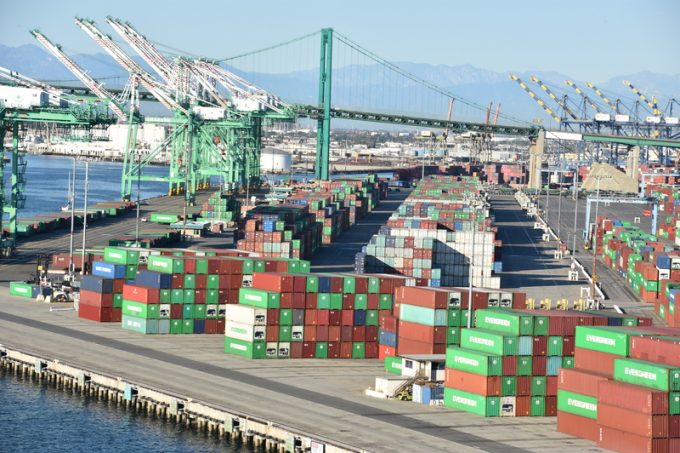Trump tariffs could spark 'global trade war', warns industry think-tank
Donald Trump has indicated that he would implement new tariffs if returned to the White ...
TFII: SOLID AS USUALMAERSK: WEAKENINGF: FALLING OFF A CLIFFAAPL: 'BOTTLENECK IN MAINLAND CHINA'AAPL: CHINA TRENDSDHL: GROWTH CAPEXR: ANOTHER SOLID DELIVERYMFT: HERE COMES THE FALLDSV: LOOK AT SCHENKER PERFORMANCEUPS: A WAVE OF DOWNGRADES DSV: BARGAIN BINKNX: EARNINGS OUTODFL: RISING AND FALLING AND THEN RISING
TFII: SOLID AS USUALMAERSK: WEAKENINGF: FALLING OFF A CLIFFAAPL: 'BOTTLENECK IN MAINLAND CHINA'AAPL: CHINA TRENDSDHL: GROWTH CAPEXR: ANOTHER SOLID DELIVERYMFT: HERE COMES THE FALLDSV: LOOK AT SCHENKER PERFORMANCEUPS: A WAVE OF DOWNGRADES DSV: BARGAIN BINKNX: EARNINGS OUTODFL: RISING AND FALLING AND THEN RISING

US west coast ports, and rail and road links to the interior, are currently struggling with a surge of imports from Asia, mostly from China.
Despite all the fiery rhetoric and tariffs, the flow of goods from China to the US has not slowed down.
“We have not seen a major slowdown in business with China, it’s pretty steady, if not growing,” said Bob Imbriani, vice-president international services of forwarder Team Worldwide.
If anything, US appetite for goods from China has increased: the country’s trade surplus with the US reached $34.2bn in August – the highest level since November 2018, when the trade conflict ramped up.
US imports overall have continued to outpace exports in recent months. Exports increased 11.8% from June to July, ending up 15.9% below their July 2019 tally, while imports maintained their upward momentum to reach pre-pandemic levels.
Strong demand for electronics has driven up US imports from several Asian origins, including Korea, Taiwan and Singapore, but China appears not to have lost out to its Asian neighbours.
In its weekly update, on 1 September, Freightos noted that shipping rates from China to the US continued to climb, driven by stronger demand than available ocean capacity. It was the sixth general rate increase in the sector since the end of May, which drove China-east coast rates past the $4,000 per feu mark.
Freightos also registered renewed interest in China as a source for US importers.
“The pandemic (and trade war) have not reduced US SMB interest in imports from China,” the update pointed out. “Freightos.com marketplace search data show China’s share of importer freight searches trended down through 2019 to a low of 88% in January. But since the rebound in US imports in June, shippers are focusing on Chinese suppliers again, as China captured 91% of searches in August.”
Team’s initial take on the lack of a shift away from China was that this was due to clients being locked into contracts and they would move once those agreements expired. However, over time, it became apparent that a large-scale exodus was not coming, Mr Imbriani said.
This year, the pandemic may have hobbled some plans to move, as US executives have been unable to travel to Asia to meet prospective new business partners and make the necessary arrangements, Mr Imbriani added, noting that restrictions have been in place in Asia almost all year.
He reckons, though, that the complexity of shifting production, coupled with the discrepancy in infrastructure between China and its neighbours, has been the biggest obstacle.
In response to the rising volumes out of other Asian economies, Team is expanding its reach in the markets.
“We’ve developed new strategic partnerships in Vietnam, we’re strengthening and have made some changes in Malaysia and Indonesia. We’re also taking some steps in India,” Mr Imbriani said.
And he sees some signs from ocean carriers that they are moving towards deploying more capacity in the emerging Asian markets. Currently these steps are rather tentative, as they try to get a clearer picture of how volumes in various markets are going to evolve, he adds.
However airlines were still rolling with the punches from their battered passenger business, he said.
“They’re struggling to stay alive and try to figure out where the patterns are,” he said.
As far as the rhetoric from the White House is concerned, the pattern to look for is one of relocating production to North America. On 7 September, President Trump issued threats to American companies that sourced overseas and those that do business in China.
“If they can’t do it here, then let them pay a big tax to build it someplace else and send it into our country,” he declared. “We’ll prohibit federal contracts from companies that outsource to China.”
He added: “We’re going to end our reliance on China because we can’t rely on China.”
It is doubtful if the markets are going to heed this in the near term, judging from recent trade numbers, not to mention the US election due in November.
Comment on this article
Cody
September 10, 2020 at 3:19 amSlow? It is not meant to slow… it is meant to increase trade. It is working.
JJ Stelman
July 22, 2024 at 12:24 pmI found this article online: https://www.zendeq.com/lanes/shippin-between-the-united-states-and-china/
Is there any way of getting updates if tariff duties change? For example, suppose there are higher import tariffs on lithium, can I get an update on that?
Alex Lennane
July 22, 2024 at 12:26 pmYou can check here: https://www.usitc.gov/tariff_affairs_announcements.htm. If I find a way of getting updates, I’ll let you know!